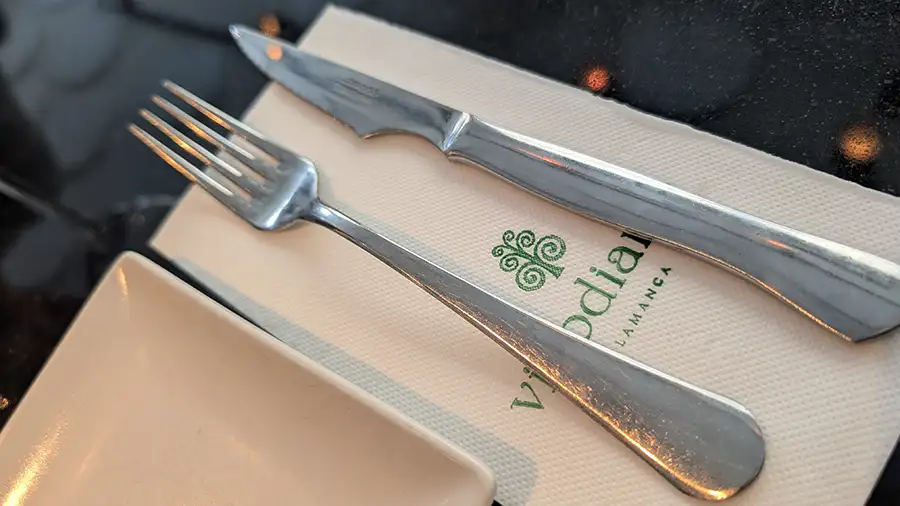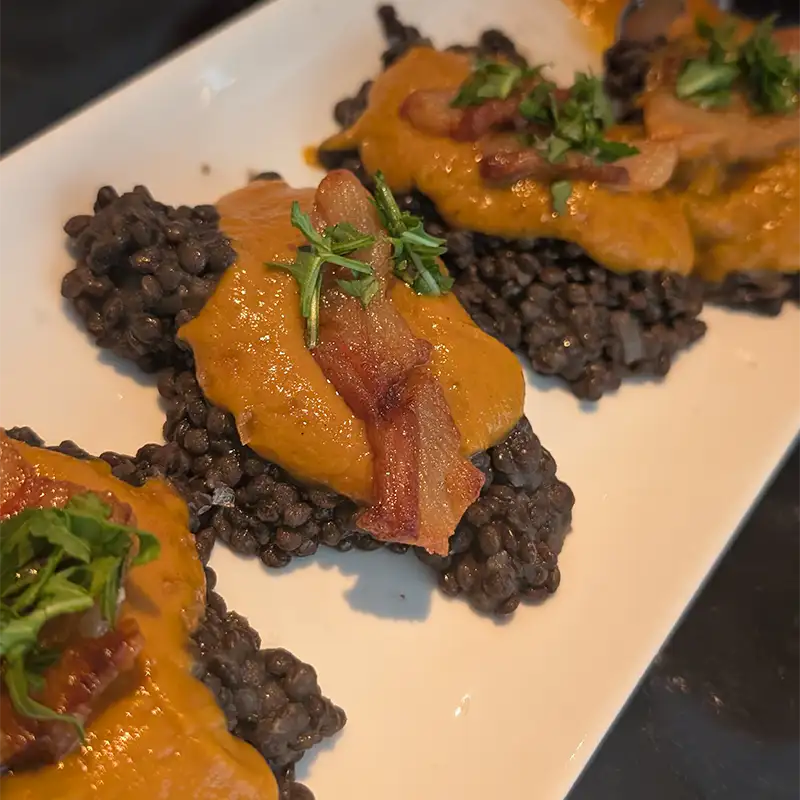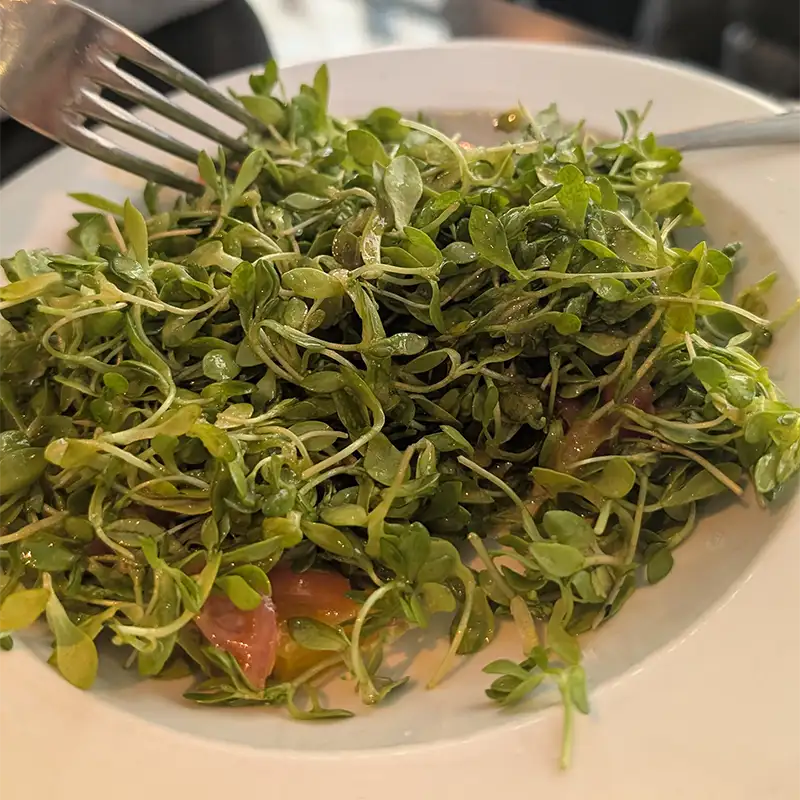Restaurants and Bars for All Tastes
Choosing where to eat in Salamanca can be a challenge, given the number of options spread across the city. To make things easier, we’ve put together a selection of places we visited and genuinely liked, offering different styles for anyone looking to eat well, whether in the historic centre or away from the more touristy areas. You’ll find more refined restaurants, traditional tapas bars and even some local favourites on Van Dyck Street, known for its affordable prices and relaxed atmosphere.
For the food lovers
To start, three restaurants ideal for those looking to go beyond the basics. Each one has its own style, but all focus on solid technique, quality ingredients and well-presented dishes.
Vinodiario
Creative cooking with seasonal ingredients and combinations that go beyond the usual without overdoing it. It also works as a wine bar, offering a selection of local labels, many of them artisanal. It’s worth asking for a pairing recommendation.
On our visit, we tried the maruja salad,made with a wild spring herb that’s rarely found on menus. Slightly spicy, it came well seasoned and topped with sweet cherry tomatoes. We also had the lentils with Iberian pork jowl and vegetable sauce. It was a simple, flavourful dish with a subtle smoky touch.
Corte & Cata
This restaurant focuses on traditional-style cooking with more refined presentation and carefully thought-out flavour combinations. You can sit in the dining area or at the bar, which works well whether you’re having a full meal or just a few tapas. One of the highlights is the wine list, which features high-end labels available by the glass. It’s a great chance to try wines that would easily cost over €100 a bottle.
During our visit, we tried the mollejas, served with a balsamic-style sauce that balanced the richness of the dish. But the real highlight was the mini pork burger. The meat was lightly smoked, the cured cheese added sharpness, and the crusty bread tied it all together. Small, straightforward and seriously well made.
Tapas 3.0
Tapas 3.0 is the newer sibling of Tapas 2.0, offering a similar concept: traditional tapas made with care and quality ingredients. The space is small, usually full, and waiting times can be long. We had to try twice before getting a table.
The best tapa of the day was the morcilla de arroz, a traditional Spanish blood sausage with rice. It was well seasoned and came with an orange sauce that balanced the stronger flavours really well. We also had the mushroom risotto, creamy, flavourful and cooked to the right texture. Simple, straightforward and very well prepared.
More down-to-earth bars
Stepping away from the more refined circuit, here come the more casual spots. These are the kind of places that feel like proper old-school Spanish bars, with packed counters, few tables, tapas on display and a lively atmosphere.
Hostería Casa Vallejo
A classic tapas bar, the kind that seems to thrive on chaos – and somehow does. There aren’t many tables, the counter is always packed, and the service is fast and to the point, sometimes even from across the room. What stands out here is the informal vibe and the fast-paced flow.
There are plenty of solid options at the counter, great for a spontaneous bite. The chicken skewer with potatoes was juicy and well seasoned. The cheese and bacon parcel was simple but spot on. The patatas revolconas and chorizo mince stick to tradition, with straightforward, homemade flavours. Nothing fancy, but everything is well made and true to its style, ideal for anyone wanting to dive into the local atmosphere and eat like they live here.
Bar La Viga
One of the most traditional bars in Salamanca, known for its speciality jeta asada, or roasted pig’s face.
This local dish is prepared with great care, resulting in a crispy exterior and tender interior, appreciated by both locals and visitors.
The setting is simple and unpretentious, with a busy counter and straightforward service that offers an authentic food experience in the city.
Fora do centro: a rua Van Dyck
Van Dyck Street is located outside the historic centre, in a more modern part of the city, and it’s a classic spot for locals in Salamanca. Don’t worry, it’s still walkable distance from the city centre. The most popular stretch is packed with bars side by side, each with its own speciality. The atmosphere is simple, prices tend to be lower and the variety of tapas is wide. It’s a great area for those who want to step off the tourist trail and eat like a local.
Van Dyck 50
One of the best-known bars on the street, Van Dyck 50 is a regular stop for locals.
The atmosphere is simple, with a traditional counter and a few tables, usually busy in the late afternoon.
The menu focuses on classic tapas, especially the skewers, which are grilled and come out quickly. We had the chicken and prawn ones, nicely seasoned and cooked just right.
Don Cochinillo
Among the many bars on Van Dyck Street, this one stood out the most. The name gives away the house speciality: roast suckling pig (cochinillo asado), served in a generous portion, with well-seasoned, tender meat and perfectly crisp skin.
We also tried the stuffed mushrooms with minced meat and garlic sauce. They were delicious. The setting follows the same line as others on the street, with tightly packed tables, a constant flow of people and no-frills service.
La Fresa
A traditional bar with nearly 40 years of history, well known among locals for its simple, well-executed cooking. The setting is straightforward, with a busy counter and freshly prepared tapas.
We tried the carrillera with caramelised onion. The meat was tender, well seasoned and the sweetness was spot on. We also had the spicy morcilla, balanced by the same onion sauce. These are classic recipes, made with care and full of flavour.
Salamanca has a strong food culture. There are many bars and restaurants recognised by guides such as Michelin and Repsol, and it’s not uncommon to find tapas with more refined presentation or less typical ingredients.
Unlike other parts of Spain, tapas here are usually not free, but they tend to be generously portioned and more carefully prepared. Even in the simpler spots, there’s a clear focus on quality ingredients and balanced flavours.
It’s worth stepping outside the historic centre and exploring areas like Van Dyck Street, where the vibe is more local and the prices more affordable. For those who enjoy good food, Salamanca has much more to offer than the basics.
































